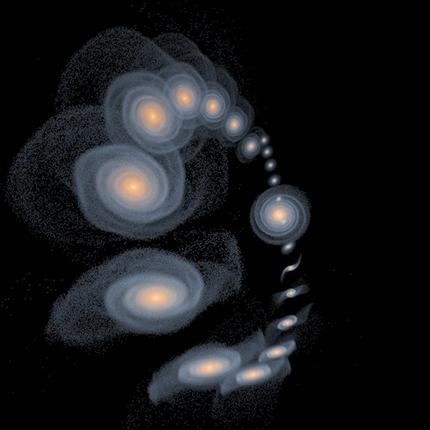This undated artist’s rendering provided by the University of Cambridge, England, shows the spiral galaxy of Andromeda, center right, over a period of about three billion years as repeated, but modified views of the dwarf galaxy Triangulum, move away from it, clockwise towards Earth, then back towards it, where Triangulum will be ultimately devoured by the Andromeda galaxy says astronomer John Dubinski. (AP Photo/Illustration by John Dubinski and Larry Widrow)
September 3rd, 2009
From Earth, the Andromeda Galaxy looks like a calm, bright galaxy, and is visible with the naked eye in our night sky. But astronomers have discovered things aren’t as tranquil as it seems over at M31. Andromeda is eating the neighbors.
The Andromeda Galaxy contains a trillion stars and lies only about 2.5 million light-years away, so it is a great object to observe and study. But recently astronomers observed wispy streams of stars on the outer fringes of Andromeda, and realized they were leftovers from a cannibalistic feeding frenzy of smaller galaxies it has absorbed.
“This is a startling visual demonstration of the truly vast scale of galaxies,” said Dr. Mike Irwin from the University of Cambridge. “The survey has produced an unrivalled panorama of galaxy structure which reveals that galaxies are the result of an ongoing process of accretion and interaction with their neighbours.”
The cannibalism continues and another victim lies in wait: M33 in the constellation of Triangulum, is destined for a future meal.
“Ultimately, these two galaxies may end up merging completely,” Dr. Scott also from the University of Cambridge. “Ironically, galaxy formation and galaxy destruction seem to go hand in hand.”
Astronomers from Cambridge were part of an international team that made a million light-year-wide survey of the Andromeda Galaxy and its surroundings using a powerful digital camera on the giant Canada-France-Hawaii telescope on Mauna Kea, Hawaii.
They discovered that many of these stars could not have formed within Andromeda itself because the density of gas so far from the galaxy’s core would have been too low to allow formation to take place. Therefore, the team reason that they are almost certainly the remnants of other, smaller galaxies which have been absorbed by Andromeda – and that Andromeda itself is still in a state of expansion.
The team’s paper argues that the larger-scale substructures identified on the galaxy’s fringes are probably the “undigested” remains of previously accreted dwarf galaxies. In all likelihood, they originally belonged to dwarf galaxies or other, proto-galactic fragments.
Article in Universe Today .
Source: PhysOrg

